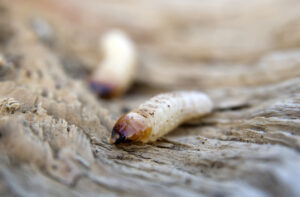
Need Help? Call Us On 0161 776 9832 For Expert Pest Control Advice On How To Identify Pest Infestations And Help Solve Your Pest Problem.
Professional Hyde Woodworm Treatment
What is Woodworm
Woodworm is not a specific insect but refers to the larval stage of a variety of wood-boring beetles. Young's Pest Control offers Hyde woodworm treatment spray and specific woodworm removal treatment furniture solutions.
Some of the more common types of woodworm
 Common Furniture Beetle.
Common Furniture Beetle.
This is by far the most common woodworm infestation and despite its name, it is as likely to be found in timber joists and floorboards as it is in furniture.
House Longhorn Beetle.
This is one of the larger species woodworms and so can cause especially severe damage. Originally a native of North Africa this beetle is often found in new houses as well as old.
Death Watch Beetle.
This is a native British insect and mainly infests hardwoods such as oak or elm although they can also be found in softwoods. The ticking sound associated with this species is caused by the beetle banging its head against wood as a mating call.
How did you become infested
The wood-boring beetle can enter your property in a number of ways. It can simply fly in, the lava may have been present in the material used in the construction of your property but is also commonly introduced along with second-hand furniture. With the increasing popularity of upcycling, the opportunities for the woodworm to be carried into your home or property has also increased. Here at Young's Pest Control, we are often asked to carry out Hyde woodworm treatment furniture solutions.
Life Cycle of a Woodworm
 1. The adult woodworm lays its eggs in the cracks and crevices of wood. This can be on furniture, floorboards or in the wooden framework of the building such as the joists or rafters in the attic.
1. The adult woodworm lays its eggs in the cracks and crevices of wood. This can be on furniture, floorboards or in the wooden framework of the building such as the joists or rafters in the attic.
2. The eggs themselves are so small they are barely visible to the naked eye. The eggs hatch after 2-4 weeks and the larvae burrow down into the wood. At this stage, there is no outward sign that you have a woodworm infestation.
3. The grubs will now spend between 2-5 years eating and burrowing their way in the timber making a network of tunnels. It is this stage of the woodworm life cycle that can cause significant structural damage to the timber in a property.
4. At the end of the larval stage, the woodworm will burrow a small chamber just below the surface of the timber. Here it finally pupates into the adult beetle and burrows its way to the surface and the cycle begins again.
Signs that you require treatment for Woodworm Removal
1. Small round holes in the timber caused by the exiting adult beetle.
2. Fine wood dust below or around wooden furniture or timber structures
3. Timber boards or joists may be crumbly around the edges, weak or damaged.
What to do next
Many of the most effective insecticide treatments used in a Hyde woodworm treatment spray are only available to certified professionals. If you think you have a woodworm infestation then call us for an expert opinion. We will inspect your property and recommend the appropriate treatment for woodworm.
Young's Pest Control offers affordable and efficient pest control for both commercial and residential properties.
